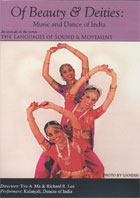
Of Beauty and Deities: Music and Dance of India 2006
Distributed by Palomino Productions, PO Box 8565, Berkeley, CA 94707; 510-236-3257
Produced by Eve A. Ma
Directed by Eve A. Ma and Richard R. Lee
DVD, color, 57 min.
College - Adult
Dance, Music
Date Entered: 09/10/2008
Reviewed by Cynthia L. Koman, Librarian, Hudson Valley Community College, Troy, NYThese two DVDs are episodes from the series The Languages of Sound & Movement. Each DVD opens with dances native to either India or Tahiti. The host is the same for each recording and interviews the dancers, musicians and artistic directors of the respective dance groups. The question and answer sections of the program provide background information on the dancers themselves, explainations of the dance movements, gestures, and costumes as well as the culture and history of India and Tahiti.
Of Beauty & Deities: Music & Dance of India is the 1st episode reviewed. The dance group, Kalanjali: Dances of India performs several classical Indian dances from the Hindus of southern India. This classical form of dance is called bharata natyam. In this style of dance, the movements and gestures spell out stories or poems to the deities and one of the dances, Kirtanam Dance Honoring Lord Krishna, (about the deity Krishna) is translated with subtitles. The meaning of this dance points out an important aspect regarding the culture of India - the deep involvement in religion. Another aspect of culture that is discussed is the significance of red, as the dancers have red dye designs on their hands and feet. These designs elaborate the gestures of the dance and are also a decorative item worn by many women in Indian. The musicians also describe the difference between Indian and Western musical scales. The basic instrument in Indian music is called a drone, which can be a musician or an electronic box. The drone gives the pitch of each song.
Pearls from the Sea: Music and Dance of Tahiti is the 2nd episode reviewed. The dance group, Te Nana ‘O Te Ra, shows us Tahitian dance. As in the other episode, we learn about the dancers and musicians through interviews by the host. Several dances are shown such as the apurima, which are dances that tell a story and the Ori, which is a free style dance. We also learn the meaning of hand gestures in the dances. Men also participate in Tahitian dances but there are no men currently in the Te Nana ‘O Te Ra dance group. The host interviews the co-artistic directors for this dance group and we learn from them a little of the religion, history and culture of the Tahitian people. One item of culture that is shared is the meaning of tattoos in Tahiti. After the age of 30 women are tattooed on their forearms and lower extremities to show that they have entered a different stage in life and are settled. The meaning of the symbols of the tattoos is explained.
The host’s delivery during these videos is dry and un-engaging at times. Sometimes she stumbles over her questions and much of the conversation is question and answer. In the Tahitian episode, there are sections where the picture quality is poor and washed out. These sections are the beach scenes which are shots mostly with bright sun creating reflecting light bouncing off the ocean and surrounding rocks on the beach. In the Indian episode, the host often talks during the dances, providing background information. While the information is helpful and interesting, it is hard to hear the host over the music of the dance.